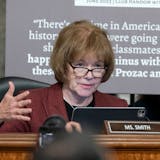Patients who have taken popular GLP-1 medications for weight loss aren’t saving themselves or their health plans any money, at least not right away.
Eagan-based pharmacy benefits manager Prime Therapeutics issued that disappointing finding this week after analyzing the health care spending of thousands of patients who started taking GLP-1 medications in 2021, comparing them with similar patients who didn’t take the drugs.
Spending was $4,206 higher per patient in the second year after they started taking the GLP-1 medications compared to the group of patients who didn’t take it, primarily because of the costly medications themselves.
“It’s too soon to conclude whether these drugs will have a return on investment from a total cost of care perspective,” said David Lassen, Prime’s vice president of primary clinical services. “We didn’t expect to see that in two years, but we were hopeful that we would start to see something!”
GLP-1 is the name for the blockbuster class of drugs such as Wegovy, Mounjaro and Zepbound that mimic a hormone called glucagon-like peptide 1, which indicates fullness and reduces appetite. Patients have reported dramatic weight loss on the medications, which researchers hoped would result in a reduction in obesity-related health complications and spending to treat those complications.
The Prime research confounded those hopes, at least in the short term. Only one in seven patients in the study group were still taking brand-name GLP-1 medications after two years, despite having continuous insurance coverage.
The study is the third in a series released by Prime as it tracks this study group, which started with 3,000 patients but has less than 500 left because of the number who discontinued their medication. Some GLP-1 medications such as Ozempic have been approved to manage diabetes, but the study focused on patients who didn’t have this chronic disease and started taking them for weight loss.
“People don’t seem to be staying on the drug as much as we had hoped,” said Pat Gleason, Prime’s assistant vice president for health outcomes.


